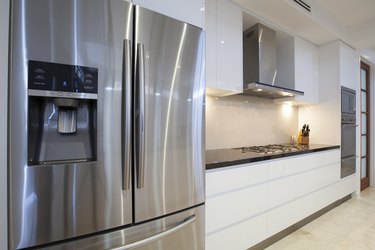
All refrigerators should come with a dial you can use to adjust the internal temperature of the fridge. The refrigerator designers give you this option for a number of reasons. Different conditions can make the refrigerator model colder or warmer, and you may need to change the settings on the refrigerator or freezer as the seasons and the temperature of your house change. If your fridge and freezer aren't cooling or your mini fridge won't get cold, follow these troubleshooting steps.
Refrigerator Temperature Dial
Video of the Day
Most refrigerators and freezers present a dial with numbers on it that represent levels of "coldness" the appliance can achieve. In almost all cases, the numbers represent the power of the refrigerator: the higher the number, the colder the appliance will get, according to Maggie's Oven Services.. Many refrigerators and freezers will suggest a starting point somewhere in the middle of the dial, which should reach an appropriate temperature under most conditions.
Video of the Day
For a refrigerator, internal temperature should be below 40 degrees F, ideally between 34 and 37 degrees F. The freezer should be near 0 degrees F. This ensures frozen food always stays frozen. Partial thawing can introduce potential health hazards.
Fridge Temperature Control — Which Is Coldest?
When it comes to fridge temperature controls and which is coldest, you may need to refer to your manual. However, as a general rule of thumb, if you need either side to be colder, turn the dial one number higher, and give the appliance 24 hours to stabilize.
You can easily tell the temperature of your refrigerator by purchasing an inexpensive thermometer and leaving it on the shelf for an hour. It's best to change the temperature inside your appliance by one number at a time so that the changes are gradual. Start with the manufacturer's recommendation and change the setting as needed.
You should be able to tell whether you need to change the settings. If you're finding food with frost on it in the refrigerator, you should probably raise the temperature slightly so that food you're storing doesn't partially freeze. If you're seeing mildew growth or leftovers that don't seem to last, you can consider making the fridge colder. Remember, the best way to keep the temperature at a good operating level is to use a thermometer to check the internal temperature.
Considerations for Temperature Changes
You can consider these factors to make sure nothing is interfering with your refrigerator's ability to keep itself cool:
- When installing the refrigerator, keep it away from heat sources like ovens, stoves, hot air vents and direct sunlight. This will help to keep the refrigerator from having to balance additional heat.
- Leave the recommended gap between the back of the refrigerator and the wall. The condenser coils need to have proper air circulation so that they can keep cooling the refrigerator properly. Making sure they have a proper allowance will help keep the refrigerator at the desired temperature. Also, occasionally vacuum the condenser coils to remove dust and debris. This will help the condenser function more efficiently.
- Inspect the door seals frequently to make sure they are still properly sealing. If not, heat can be leaking into the refrigerator, warming up the interior. If you see signs of damage, wear and tear or cracking, you may want to call a certified repair person to come take a look.
- Avoid placing hot foods in the refrigerator. Let cooking come to room temperature before putting it into the refrigerator. Hot food placed into a cold environment will require more energy from the fridge, and it can occasionally damage glass or ceramic containers.
- An over-full refrigerator will be harder to keep cool. If you are having difficulty and your refrigerator shelves are packed, try removing items that may be past their expiration date. Air needs to be able to circulate in order for the refrigerator to stay cool.
These tips will help you maintain a proper temperature in your refrigerator, which will keep your food fresh and safe.